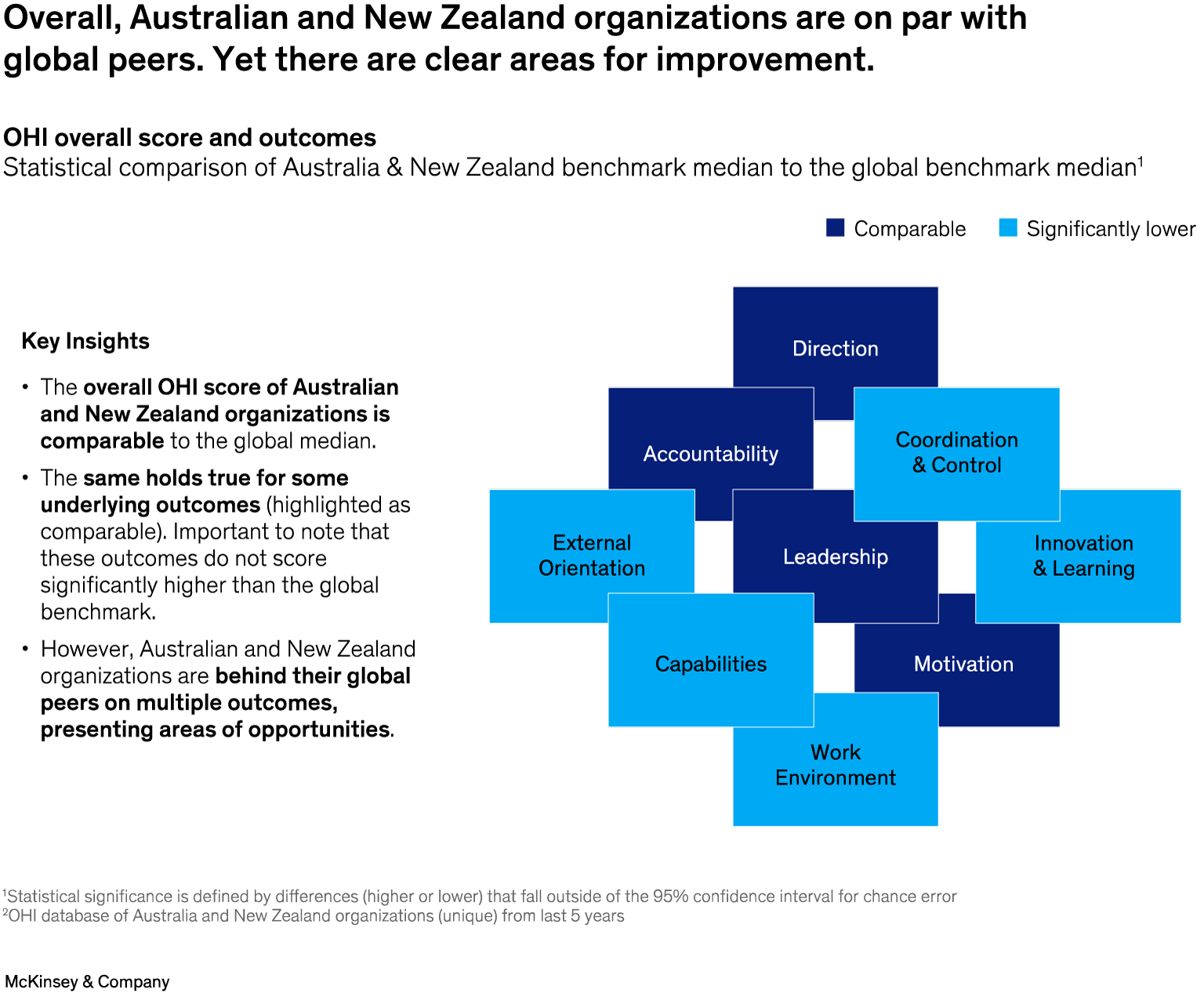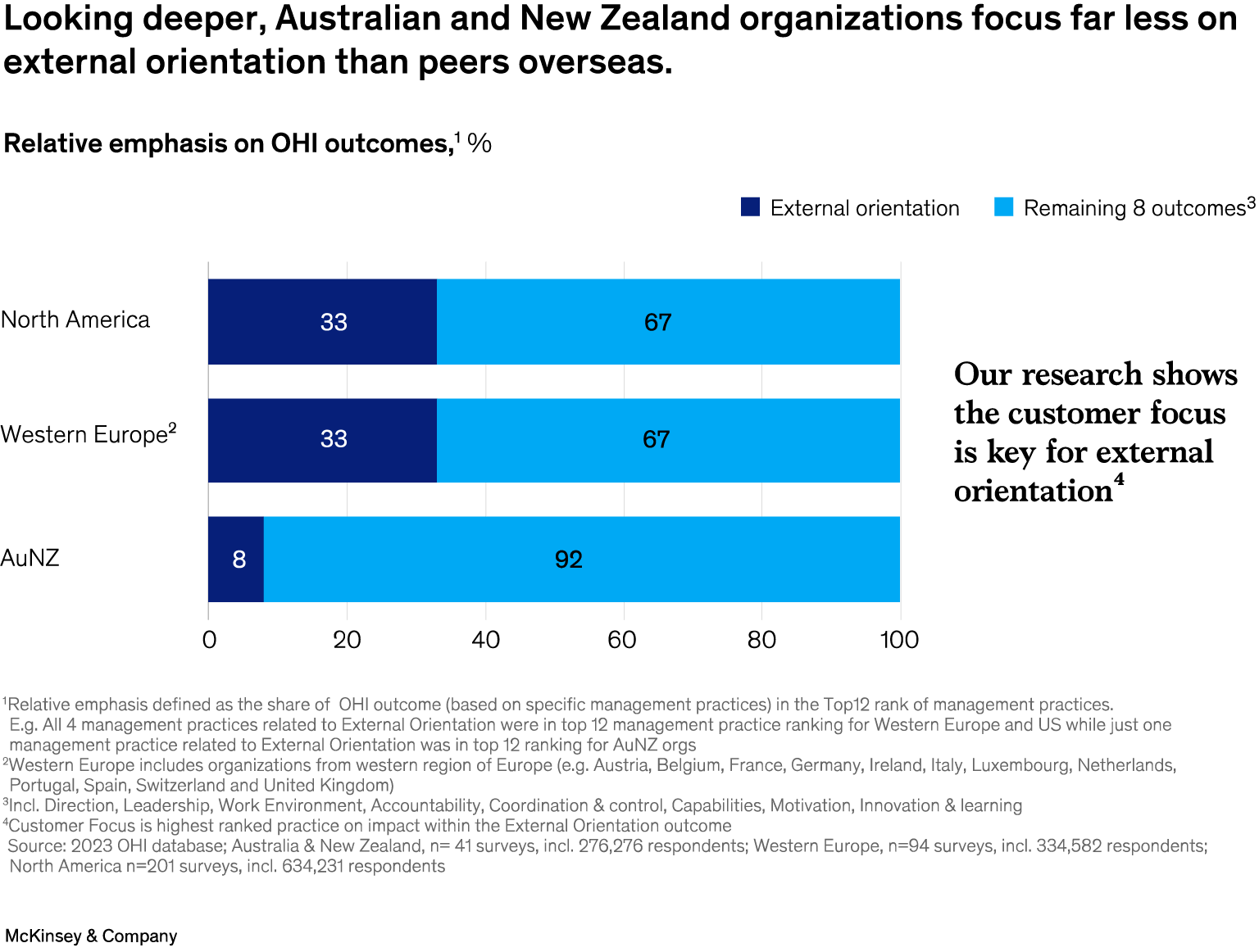Seizing the upside: improving organizational health for Australian and New Zealand companies
Amid the set of opportunities and challenges organizations are facing today it might be forgivable for organizational health not to dominate senior leadership attention in Australian and New Zealand businesses.
But what is forgivable is seldom what succeeds. Amid inflationary pressures, changing customer preferences, and an explosion in AI and data opportunities, it remains vital for Australian and New Zealand businesses to check if they are fit enough for our rapidly changing times and future.
Our research, spanning more than 20 years and covering more than 8 million respondents, continues to show that organizational health strongly correlates with long-term performance, as well as the ability of businesses to boost the odds of sustaining transformation efforts.
We define health as an organization’s ability to align around a common vision, execute against that vision effectively, and renew itself through innovation and creative thinking -- a concept some would refer to as “culture”. To support this, the McKinsey OHI measures organizational outcomes (what you see in the organization) as well as the management practices (daily behaviors) that drive those outcomes. Periodically, McKinsey will snapshot OHI data for Australian and New Zealand companies against the global data, to highlight strengths of Australian and New Zealand organizations, and identify opportunities for improvement.
Organizational Health in Australia and New Zealand
So, how does the organizational health of Australian and New Zealand businesses compare to global peers? What aspects of organizational health do employees in our region most value? And what can leaders do to further improve organizational health and – more importantly – boost performance?

Exhibit 1: Organizational health of Australian and New Zealand organizations compared to global median.
The latest OHI results across more than 40 businesses, covering more than 275,000 employees, across more than ten sectors, show that, overall, the organizational health of Australian and New Zealand companies is on par with global peers. However, upon looking deeper, there are certain aspects where organizational health in Australia and New Zealand is significantly below the global median (Exhibit 1). Businesses stand to gain significant advantages by enhancing their focus on and performance against these key organizational health outcomes.
Four themes emerge for Australian and New Zealand businesses
When we compare the OHI data of Australian and New Zealand businesses against overseas organizations, four themes emerge showing what Australia and New Zealand organizations are already getting right, and where more can be done.
- Egalitarian ‘mateship’ culture is an imperative
First, the good news, most Australian and New Zealand organizations already excel in creating warm and open workplaces in which employees can connect with their organization, through strong values they can relate to and leaders they admire. This is not surprising in a region that is somewhat socially defined by an egalitarian ‘mateship’ culture.
- Further involve employees in strategic planning
Second, and looking deeper, the healthiest organizations in the region go a step further to involve employees and enhance their ownership and belonging to the organization by engaging their employees in the overall strategy and building a sense of personal obligation for delivering organizational goals.
- Make performance matter
While Australian and New Zealand organizations demonstrate significant ‘internal’ strengths, this needs to be balanced with a stronger emphasis on talent growth and performance management. By improving performance feedback and assessments to evaluate, develop and deploy people, leaders can enhance employee engagement and uplift capabilities across the organization.
- Enhance external focus – especially on customers
In addition to making performance matter, global peers place a strong emphasis on external orientation. This involves putting customer impact at the forefront of the decision-making process while also reflecting on competitors’ strengths and weaknesses during decision-making (Exhibit 2)

Exhibit 2: Australian and New Zealand organizations lack in external focus when compared to global peers.
In prioritizing internal culture, Australian and New Zealand businesses may be under-emphasizing competitive advantages like external orientation, and elements of execution.
And if so, then how do Australian and New Zealand organizations embrace more emphasis on external orientation while keeping employees motivated and accountable? In the above four themes, we see the opportunity for businesses to build on their existing, supportive work environment and value-based culture to embrace and capitalize on the successful qualities we see in global healthy organizations.
In today’s disruptive marketplace where organizations must adapt quickly to the world around, it is critical that they instead look outside their walls to understand the changes (and the opportunities). It’s also important for them to build a strong performance management muscle to deliver on the strategic priorities. That will require:
- Linking organizational objectives with individual performance (e.g., establishing consumer metrics in incentive programs to embed a customer focus)
- Engaging in regular two-way feedback conversations linked to an individual’s long-term development, career plans, and performance objectives
- Ensuring organizational systems and processes enable customer-centricity (e.g., customer metrics built into key business processes, mapping customer journeys to identify and eliminate pain points, clear decision rights for frontline)
- Learn from best-practices and regularly bring external perspectives into relevant decisions (e.g., pricing, product development)
Teams should be empowered to look externally – even to competitors – for both data and inspiration.
Cornerstones of successful organizational health transformations
While there is no one recipe for success and changing the culture of an organization, there are some critical success factors that enable organizations to truly transform:
- Define the big shifts: Focus on a few mindsets shifts that are needed (and really matter) for your organization – linked to clear financial and operational values – and create interventions to change those paradigms.
- Link to the operating model: Use your operating model levers (purpose, structure, processes, people, tech) to drive and sustain change, delivering through existing programs and priorities.
- Make change personal: Support change to the work context (outside-in) and by giving people space to choose to change (inside-out).
- Walk the talk: Role model desired behaviors and ensure there is real consequence management for culture change from top to bottom.
- Manage with rigor: Give importance to the health improvement the same way as the financial performance. Rigorously measure the culture change (both activity and impact) with layered feedback to ensure continuous improvement.
Getting Started
Australians and New Zealanders, connected by their geographical remoteness, share a history of recognizing the importance of looking 'over the horizon.' Given the past few pandemic years, a noticeable shift toward internal alignment is understandable, as reflected in our OHI results. However, these results also indicate that the time has come for teams and businesses in Australia and New Zealand to reorient their focus outward once again.
For many businesses this re-focus will require change management that is driven with emotional intelligence and clear communication to build internal momentum. Setting clear and bold aspirations is often the first step in the journey. For real change to be delivered, it is important to complement these bold aspirations with a data-driven baseline to assess day-to-day behaviors and practices in your organization. McKinsey’s Organizational Health Index assesses both the effectiveness of an organization’s practices and the outcomes they drive to understand what is working well and what needs improvement.
****
By being more externally focused and bringing rigor to the way we measure and track people performance, Australian and New Zealand businesses can harness the full potential of their existing organizational strengths while enhancing the ability to execute, innovate, and foster creative renewal. This strategic pivot can offer tangible competitive opportunities for businesses to seize the upside.
About the authors
Ben Fletcher is a senior partner in McKinsey’s Sydney office. Chris Hartley is a partner in McKinsey’s Melbourne office where Priyanjali Arora is a Manager of Solution Delivery.
The authors would like to acknowledge Chaitanya Parab and Pawel Poplawski for their contributions to this research.


